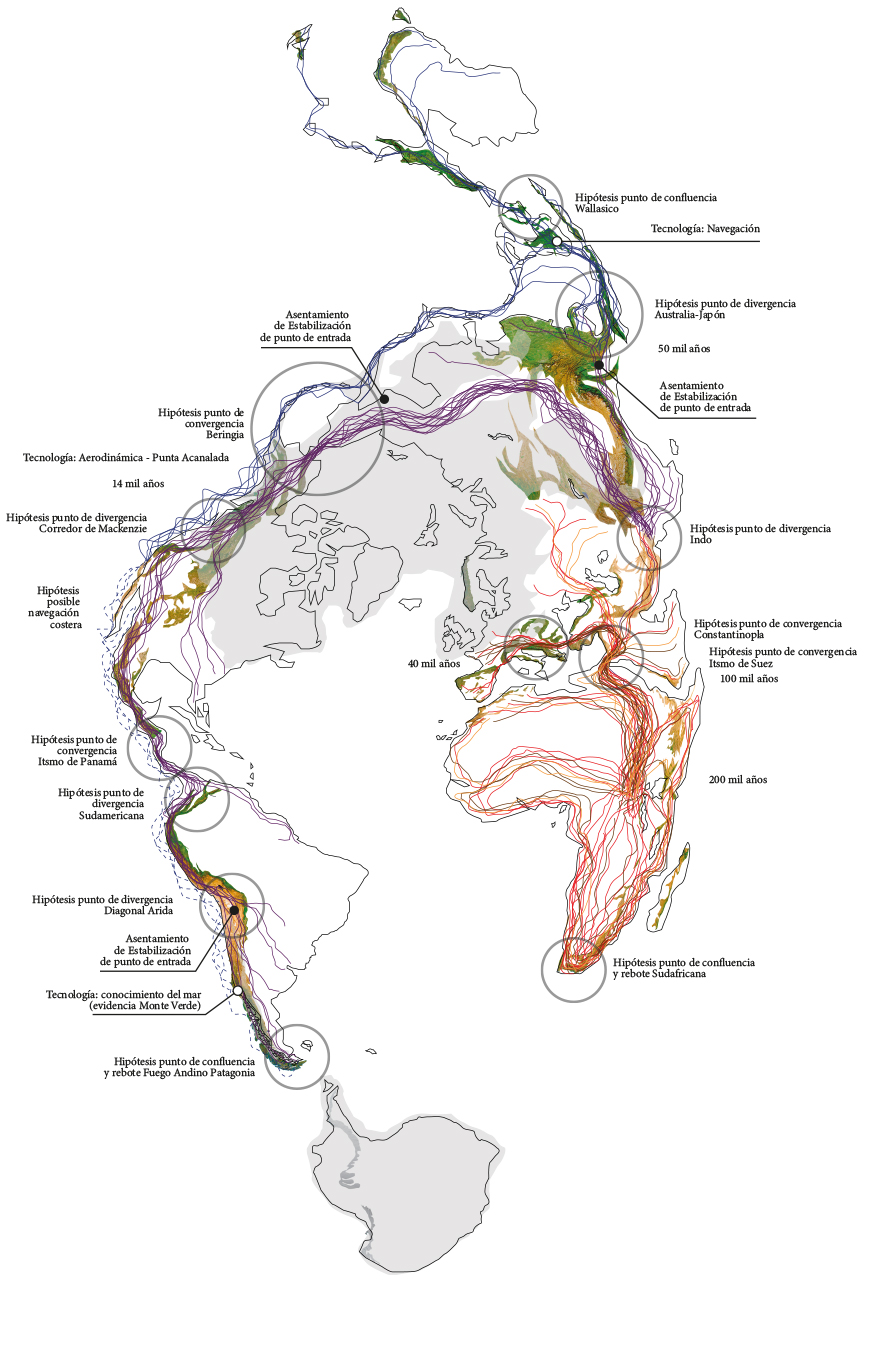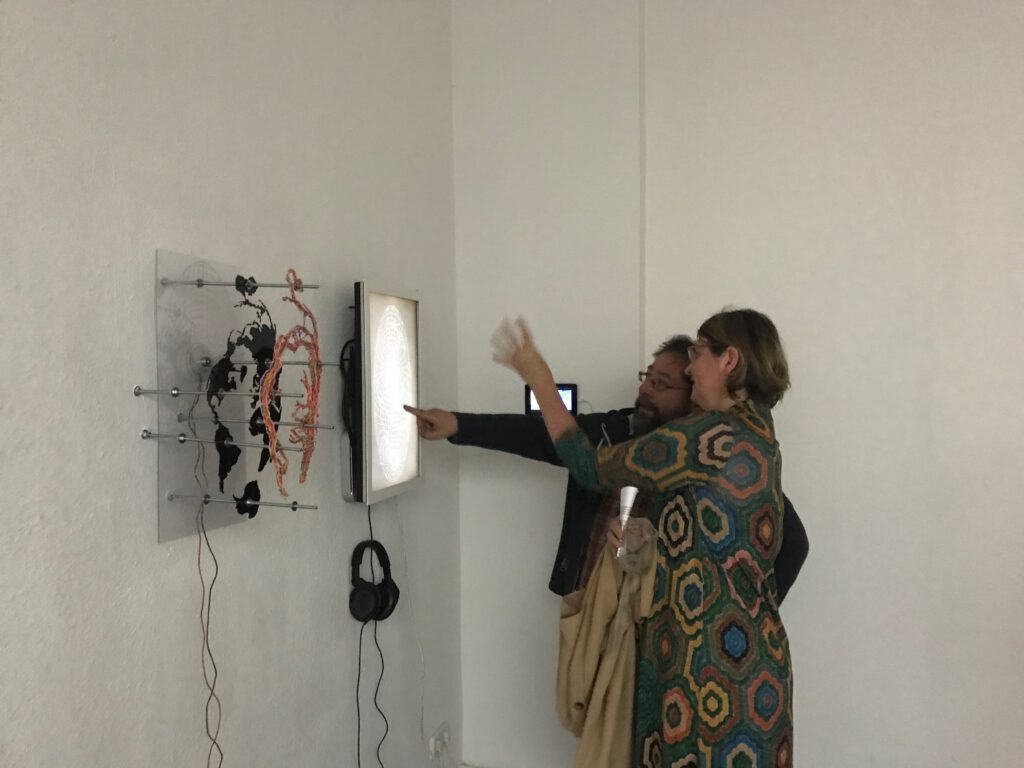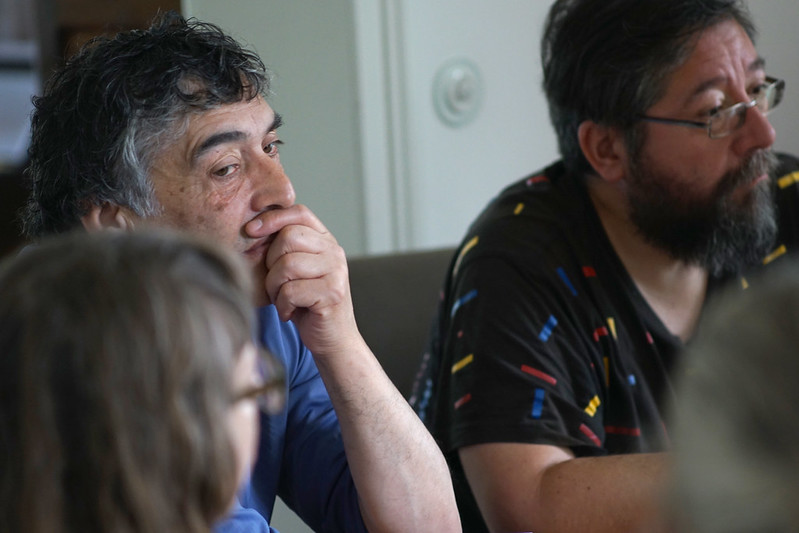Realización: Alfredo Prieto y Cristian Espinoza
Voz: Jasmine Guffond grabada por Kerstin Ergenzinger
Animación: Mario Campos Castellano
Producción de Nicolas Spencer
Expedición Sonic Island – Rügen 2023 dirigida por Carsten Stabenov
duración: 6:10 min.
año: 2023
single channel video HD, estereo
1 un solo archipiélago
Tomaremos el mapa Atlántico de John Bartolomew como superficie.
Haremos esto para intentar ver en un solo gesto todas piezas
que hemos llamado islas y continentes disgregados.
Donde hemos aprendido a ver cuerpos desmembrados, lejanos, a veces en colisión,
nosotros vemos un solo archipiélago y sin importar el tamaño
vemos conjuntos de recuerdos de una era anterior en que todo estaba reunido.
2 mapa huevo
Sobre el mapa veremos un movimiento único de doscientos millones de años,
un movimiento que va tejiendo el conjunto de islas,
movimiento que se emplaza en las superficies y aprende a habitarlas,
y en ese aprender, aprende a dar un nuevo paso de forma distinta,
estableciendo relaciones cada vez más excéntricas con los distintos paisajes que se abren a ante sí.
veremos en el archipiélago, una síntesis de la proliferación de las diferentes humanidades
desde su origen en el centro de África hasta la Tierra del Fuego durante la última glaciación llamada de Würm.
3 mapa cordilleras y ríos
El individuo humano es parte de una masa que se mueve o se ha movido a distintas velocidades a lo largo del tiempo.
Esa masa en movimiento se ha diversificado también y ha vuelto a fusionarse en distintos momentos de su historia.
Las causas de esta dinámica no son del todo conocidas, pero pueden estar relacionadas con la forma de la tierra
y sus eventos de acogida o rechazo.
Nuestra visión de la dinámica humana introduce el concepto de grandes corrales para entender esos movimientos. Pero, no es la dirección la que importa,
sino el llenado del espacio antes de moverse para posibilitar así siempre el retorno.
4 movimiento AFRICA
Todos los lugares parecen conducir a una primera pared, y esa pared es el mar,
porque originalmente los Humanos Anatómicamente Modernos no sabían ni nadar ni construir embarcaciones.
De modo que se movían donde podían, pero siempre enfrentados a la larga con el mar.
El mar hace rebotar hacia el centro o seguir la costa un tiempo y avanzar
y retroceder según las circunstancias
y quedarse, al menos una buena parte de la masa que sigue en movimiento lento,
pero, a la larga, siempre hay alguien que ha salido y que traerá noticias de otras tierras.
5 movimiento istmo de Suez
Los primeros HAM no buscan una salida,
pero de tanto moverse la encuentran, como otras veces, anteriormente, lo hicieron otras especies.
Y esa salida es principalmente la península de Sinaí,
por ser el único paso terrestre existente desde siempre entre el continente africano y el asiático.
Este es el primer gran corral que conduce a los HAM fuera de África,
la gran puerta de entrada a otros mundos.
Ya el HAM se ha convertido en Homo Sapiens-Sapiens, Nerdenthal, Denisovanos entre otros
y se ha mestizado y diversificado.
Los Neanderthal tienen una preferencia por Europa occidental,
los Denisovanos por el centro de Eurasia
y los Homo Sapiens-Sapiens están en todos los lugares disponibles llenando todos los espacios.
6. movimiento indo
Comienzan los procesos de diversificación y mezcla,
aparecen nuevas herramientas entre las cuales la más importante será la navegación.
Los corrales conducen a otros extremos,
las paredes de los cuales serán más y más difusos dada la extensión de las grandes islas,
pero se poblarán nuevos ambientes antes denegados como las grandes alturas
e incluso los desiertos áridos.
7. Beringia
La Beringia es una gran extensión de tierra disponible
por el descenso del nivel del mar durante la ultima glaciación (Wurm)
Esta a la puerta de una nueva gran isla, América,
pero esta se encuentra cerrada de hielo, que sin embargo se derrite.
Aquí se entra y se sale, se parece a una espera, una antesala,
pero mientras haya hielo no se verá.
8. Mackenzie
entre islas se emplea un nuevo medio de navegaciones que abren nuevo mundo al sur, ya sea por la costa,
o por el interior, por el valle del rio Mackenzie.
Las especies animales no conocen a los humanos, eso las hace fáciles de cazar, es un paraíso.
9. Sudamérica
Las posibilidades de moverse por este nuevo continente son amplias en la medida en que se desplazan al sur del polo,
pero en algún momento se estrechan considerablemente al encontrarse en el istmo de Panamá.
Si habían poblaciones largamente descendiendo por la costa mientras otras lo hacían por el interior
o incluso llenaron el espacio hasta la costa atlántica, este era el lugar de reencuentro.
Si las costas funcionaron como paredes y autopistas, hay una que aparece en el interior, despejada y previsora,
la Diagonal Árida entre la Puna y la Patagonia.
Aquí habrán nuevas separaciones y encuentros, ideas y retornos y también navegaciones.
Pero aquí se acaba el camino, sólo resta la Antártica que no será nunca poblada.
10. Final, solo el movimiento humano
La humanidad, vista en un solo gran movimiento nos parece desde aquí una propagación continua,
en un movimiento enmarcado en corrales y a veces acelerado por cuencas hidrográficas.
Un movimiento de cientos de miles de años de avance, retorno
y aprendizaje de tecnologías para profundizar su forma de habitar el archipiélago.
A veces cuando la humanidad diverge
olvida tras varias generaciones su unidad mezclada una y otra vez
y al volver a converger le cuesta reconocer a los otros viajeros como parte de la misma unidad.
1 a single archipelago
We will take John Bartholomew’s Atlantic map as a surface.
We will do this to try to see in a single gesture all the pieces
that we have called islands and disintegrated continents.
Where we have learned to see dismembered, distant, sometimes colliding bodies,
we see a single archipelago and regardless of size
we see sets of memories of an earlier era when everything was reunited.
2 map egg
On the map we will see a unique movement of two hundred million years,
a movement that weaves the set of islands,
a movement that settles on the surfaces and learns to inhabit them,
and in this learning, learns to take a new step in a different way,
establishing increasingly eccentric relationships with the different landscapes that open up before it.
We will see in the archipelago, a synthesis of the proliferation of the different humanities
from its origin in the center of Africa to Tierra del Fuego during the last glaciation called Würm.
3 map of mountain ranges and rivers
The human individual is part of a mass that moves or has moved at different speeds over time.
That moving mass has also diversified and re-merged at different times in its history.
The causes of these dynamics are not entirely known, but may be related to the shape of the earth
and its welcoming or rejecting events.
Our view of human dynamics introduces the concept of large corrals to understand these movements. But, it is not the direction that matters,
but the filling of the space before moving to always enable the return.
4 movement AFRICA
All places seem to lead to a first wall, and that wall is the sea,
because originally the HAMs knew neither how to swim nor how to build boats.
So they moved wherever they could, but always facing the sea in the long run.
The sea makes them bounce towards the center or follow the coast for a while
and move back and forth according to the circumstances
and stay, at least a good part of the mass that follows in slow movement,
but, in the long run, there is always someone who has left and who will bring news from other lands.
5 movement of the isthmus of suez
The first HAMs do not look for an exit,
but they find it by moving so much, as other species of the genus did before.
And that exit is mainly the Sinai peninsula,
as it is the only land passage that has always existed between the African and Asian continents.
This is the first great corral that leads the HAM out of Africa,
the great gateway to other worlds.
Already the HAM has become Homo Sapiens Sapiens, Nerdenthal, Denisovanis among others
and has interbred and diversified.
The Neardenthal have a preference for western Europe,
the Denisovans for central Eurasia
and the HSS are everywhere available filling all the spaces.
6. indo movement
The processes of diversification and mixing begin,
new tools appear among which the most important will be navigation.
The corrals lead to other extremes,
the walls of which will be more and more diffuse given the extension of the large islands,
but new environments previously denied as the great heights
and even arid deserts will be populated.
7. Beringia
The Beringia is a large expanse of land made available
by the lowering of the sea level during the last glaciation (Wurm).
It is at the gateway to a new large island, America,
but it is enclosed by ice, which is melting.
Here you enter and leave, it looks like a waiting, an anteroom,
but as long as there is ice you will not see it.
8. Mackenzie
among island a new means of navigations is employed which open new world to the south, either by the coast,
or by the interior, through the Mackenzie River Valley.
The animal species do not know humans, that makes them easy to hunt, it is a paradise.
9. SOUTH AMERICA
The possibilities of moving through this new extension are ample as they move south of the pole,
but at some point they narrow considerably as they meet at the isthmus of Panama.
If populations had long descended along the coast while others moved inland
or even filled the space to the Atlantic coast, this was the place of reunion.
If the coasts functioned as walls and highways, there is one that appears in the interior, clear and foresighted,
the Arida diagonal between the Puna and Patagonia.
Here there will be new separations and encounters, ideas and returns and also navigations.
But this is the end of the road, only Antarctica remains, which will never be populated.
10. Final, only the human movement
Humanity, seen in a single great movement, seems to us from here a continuous propagation,
in a movement framed in corrals and sometimes accelerated by hydrographic basins.
A movement of hundreds of thousands of years of advancement, return
and learning of technologies to deepen their way of inhabiting the archipelago.
Sometimes when humanity diverges
it forgets after several generations its unity mixed again and again
and when it converges again it finds it difficult to recognize the other travelers as part of the same unity.



